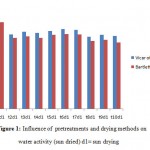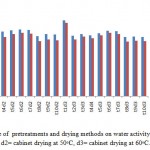How to Cite | Publication History | PlumX Article Matrix
Influence of Osmotic Pretreatments and Drying Methods on Water Activity of Dried Pear
Rehana Salim, A. H. Rather and H. R. Naik
Division of Post Harvest Technology, Sher-e- Kashmir University of Agricultural Sciences and Technology Kashmir, Shalimar, Srinagar, J and K, India-190025. Corresponding Author E-mail: rehana_salim@yahoo.in
DOI : http://dx.doi.org/10.13005/bbra/2306
ABSTRACT: The aim of this study was to evaluate the impact of pretreatments viz glucose, sucrose, glycerol and drying techniques (sun drying and cabinet drying at 50ᵒC and 60ᵒC) on water activity of dried pear slices. The concentration of all the osmotic agents was regular (60%). The impact of drying techniques and pretreatments were found measurably critical (p≤0.05). The lowest water activity (aw) was found in cabinet dried pear at 60ᵒC and highest in sun dried pear slices. Samples treated with glycerol reached the lower water activity values than treated with glucose and sucrose.
KEYWORDS: osmotic dehydration; water activity; drying
Download this article as:| Copy the following to cite this article: Salim R, Rather A. H, Naik H. R. Influence of Osmotic Pretreatments and Drying Methods on Water Activity of Dried Pear. Biotech Res Asia 2016;13(3). |
| Copy the following to cite this URL: Salim R, Rather A. H, Naik H. R. Influence of Osmotic Pretreatments and Drying Methods on Water Activity of Dried Pear. Biotech Res Asia 2016;13(3). Available from: https://www.biotech-asia.org/?p=15833 |
Introduction
Pear fruit (Pyrus communis L.) belongs to the family Rosaceae, subfamily Maloideae or Spiraeoideae and genus Pyrus L. [1]. Due to its low caloric and high nutritive value, it is much appreciated among the consumers. Pear fruit is rich in both macronutrients and micronutrients [2].
Most fruits and vegetables have a definite harvesting time and a limited shelf-life. Harvested fruits deteriorate quickly due to microbial and biochemical activities. However, different techniques are used to extend their shelf-life by a few weeks, one year or more. [3]. The common processing techniques of pears are, to preserve in syrup, to convert in purees to be used in nectars, yogurts, canning and drying [4].
Osmotic dehydration is an efficient form of moisture elimination from solid food, inflicting no change in phase of water [5]. In fruits about 50% of their original weight is reduced when subjected to osmotic treatments before drying [6]. It is often carried out as a pre-processing step before foods are subjected to further processing such as air drying [7], vacuum drying [8], freezing [9], freeze drying [10], sun drying, pasteurisation or acidification and coating by edible surface layers [11]. Besides, osmotic dehydration is used to treat fresh produce to improve sensory, functional and even nutritional properties.
This technique is based on the immersion of fruits in a hypertonic solution. This hypertonic solution affords a higher osmotic pressure and a lower water activity [6]. Water activity aw is a better indication of food perishibility. It is the term that relates to potential of a microbe to grow in a selected surroundings. Removal of water by drying or concentration will lessen its susceptibility to microbial assault [12]. During the osmotic dehydration, three types of mass transfers in countercurrent flux can occur [6]: water flux from the product to the solution; solute transference, from the solution to the product, and natural solutes (organic, mineral sugars, acid, vitamins, etc.) flux, from the fruit to the solution resulting in the removal of water which eventually leads to lower water activity.
Osmotic dehydration of pear can be a useful technique to preserve and obtain new processed products of interest to the consumer. The aim of this study was to evaluate the effect of osmotic dehydration on water activity of pear slices for shelf life extension.
Material and Methods
Two varieties of pear (vicar of winkfield and Bartlett) were selected for the study. Fruits were sorted, washed with water and peeled manually. Both the varieties were sliced to 10mm thickness by power operated slicer and immersed in glucose, sucrose and glycerol solutions for 12 hrs. Following osmotic treatments were applied before drying.
T1 control (plain water)
T2 pear slices were immersed in 60% Glucose + 0.5% KMS
T3 pear slices were immersed in 60% Glucose + 0.5 % Ascorbic acid
T4 pear slices were immersed in 60% Glucose + 0.25 % KMS +0.25% Ascorbic acid
T5 pear slices were immersed in 60% sucrose + 0.5% KMS
T6 pear slices were immersed in 60% sucrose + 0.5% Ascorbic acid
T7 pear slices were immersed in 60% sucrose + 0.25 % KMS +0.25% Ascorbic acid
T8 pear slices were immersed in 60% Glycerol + 0.5% KMS
T9 pear slices were immersed in 60% Glycerol + 0.5% Ascorbic acid
T10 pear slices were immersed in 60% Glycerol + 0.25 % KMS +0.25% Ascorbic acid
Sun Drying
Pretreated samples of both the varieties from all the treatments were spread on alumunium trays (75 x 45 x 6cm) and placed under direct sunlight during day time between 9 am to 5 pm. Samples were given regular turnings to achieve uniform drying. On each day the samples were collected in the evening and kept in perforated and closed polyethylene bags and spread out again on the following day. Samples were dried till the predetermined moisture level of 10-12 per cent was achieved.
Mechanical Drying
Pretreated Pear varieties were loaded on aluminum trays (75 x 45 x 6cm) as described in sun drying. The loaded trays were kept in cabinet drier and drying was conducted at two temperatures levels i.e 50oC and 60oC till the predetermined moisture level of 10-12 per cent was achieved. Following drying all the treated samples were packed in polypropylene boxes. Water activity (aw ) was analysed by using water activity meter.
Results and discussion
 |
Figure 1: Influence of pretreatments and drying methods on water activity (sun dried) d1= sun drying.
|
 |
Figure 2: Influence of pretreatments and drying methods on water activity (cabinet drying) d2= cabinet drying at 50ᵒC, d3= cabinet drying at 60ᵒC.
|
As it is widely known that the stability and safety of foods enhance if the water activity of the product decreases. The water activity of foods affects the multiplication, metabolic activity, resistance and survival of the organism present [13]. The reduction of aw to about 0.93 might be enough to suppress the growth of most pathogenic bacteria [14]. Most mould and yeast strains are inhibited between aw of 0.88 and 0.80, even though a few osmophilic yeast lines can nevertheless develop right down to aw of 0.6 [15].
The results from the present study showed that the mechanical drying produced the lowest aw compared to sun drying. Among both the varieties, the lowest water activity of 0.367 was recorded in Bartlett in T8 (Glycerol + KMS and dried in cabinet drier at 60ᵒC) and highest of 0.519 was recorded in vicar of winkfield in T1 (control and sundried sample). Effect of drying methods and pretreatments on the water activity values were statistically significant (p≤0.05).
As evident from the Fig 1 and Fig 2 all the treatments resulted in reduction in aw as compared to fresh fruit. The osmotic pretreatments were more efficient in reducing aw as a large amount of water was removed at some stage in osmosis and incorporation of sugars occurred. Similar results were reported in osmotically dehydrated mango [16].
Fruits treated with glycerol reached lower water activity values than those treated with glucose and sucrose. This can be due to glycerol, a polyhydric alcohol, decreased the aw by means of hydrogen binding with it [17]. The results were in agreement with the findings of Ayub [18] who reported a decrease in aw of persimmon slices. Panwar et al [19] reported the similar results in aonla segments.
Conclusion
It is concluded that the osmotic dehydration is an effective way of lowering the water activity of pear slices thus have the extended shelf life even without refrigeration. All the pretreatments resulted in lower water activity values however pear slices treated with glycerol reached the lowest water activity values irrespective of the varieties. Further mechanical drying resulted in lower water activity as compared to sun drying.
References
- Brian, A. F., & Cameron, A. G. Food science, Nutrition and health, 5th Edward Arnold publisher, London. 1995; 266-284.
- Silos, E. H., Morales, F. L., Castro, J. A., Valverde, E., Lara, F., Lopez, O. Chemical and biochemical changes in prickly pears with different ripening behaviours. 2003; 47: 334-338.
- Burrows, G. Production of thermally processed and frozen fruit. In: Fruit processing. [Eds. Artley and P.R. Ashurst]. Blackie Academic and Professional, London, UK, 1996; pp. 135-164.
CrossRef - Guiao, E. P. A cultura da pereira (2nd ed.). Sao Paulo: ABC do Lavrador Pratico, 1964; 31.
- Bolin, H. R., Huxsoll, C. C., Jackson, R., Ng, K. C. Effect of osmotic agents and concentration on fruit quality. Food Sci. 1983; 48: 202–205.
CrossRef - Raoult-Wack, A. L. Recent Advances in the osmotic dehydration of foods. Food Sci.Technol. 1994; 5: 255–260.
- Nanjundaswamy, A. M., Radhakrishnaiah, A., Setty, G., Balachandran, C., Saroja, S., Murthyreddy, K. B. S. Studies on development of new categories of dehydrated product from indigenous fruits. Indian Food 1978; 22: 91-93.
- Dixon, G. M., Jen, J. J. Changes of sugar and acid in osmovac dried apple slices. Food Sci. 1977; 42: 1126-1131.
CrossRef - Ponting, J. D. Osmotic dehydration of fruits – recent modifications and application. Biochem. 1973; 8: 18-20.
- Hawkes, J., Flink, J. M. Osmotic concentration of fruit slices prior to freeze dehydration. Food Prod. Preservation. 1978; 2: 265-284.
CrossRef - Flink, J. M. Dehydrated carrot slices: influence of osmotic concentration on drying behaviour and product quality. In: Food Process Engineering. [Eds. Linko, Y. Malki, J. Olkku, J. Larinkari, P. Fito, E. Ortega and G. Barbosa]. Applied Science Publishers, London, 1979; pp. 412-418.
- Shewfelt, R. L. Introducing Food science. CRC press, Great Britain, 2009.
- Leistner, L., Rodel, W., Krispien, K. 1981. Microbiology of meat and meat products in high and intermediate moisture ranges. In: Water activity: Influences on food quality. Academic press, New York, 1981; P. 855.
CrossRef - Chirife, J., Favetto, G. J. Some physicochemical basis of food preservation by combined methods. Food Res. Int. 1992; 25: 389-396.
CrossRef - Iglesias, H. A., Chirife, J. Handbook of food isotherms. Academic press, New York, 1982; P. 347.
- Sabrina Bernardi., Renata, B., Bodini, Bruna Marcatti., Rodrigo Rodrigues Petrus., Carmen silvia Favaro-Trindade. Quality and sensorial characteristics of osmotically dehydrated mango with syrups of inverted sugar and sucrose. Agric. 2009; 66: 40-43.
- H Charley. Food science, John Wiley and sons, Inc., USA, 1982.
- M Ayub. Effect of sweeteners on the wateractivity and shelf stability of osmotically dehydrated persimmon slices. Sarhad J. Agric. 2003; 19: 563-570.
- Panwar, S., Gehlot, R., Siddiqui, S. Effect of Osmotic agents on intermediate moisture Aonla segments during storage. J. Agric. Food Sci. Technol. 2013; 4: 537-542.

This work is licensed under a Creative Commons Attribution 4.0 International License.





